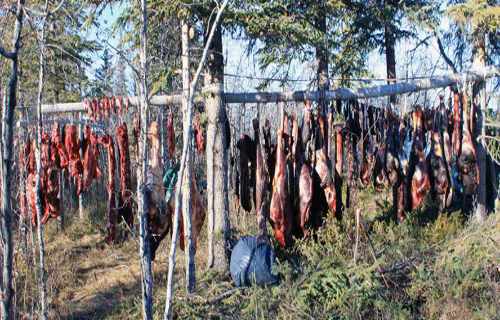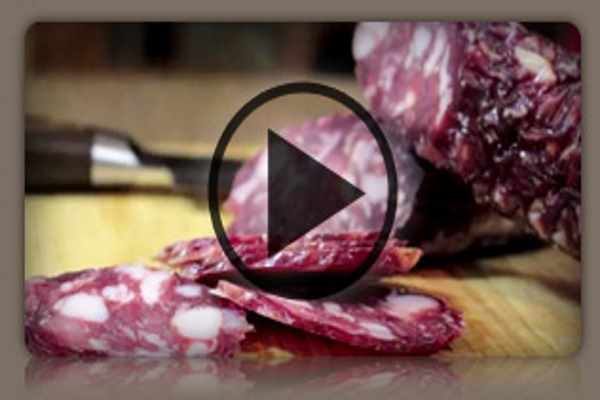Considering that in the near future energy will no longer be a modern day commodity, but a luxury hard to come by, learning how to preserve meat and store your own food is crucial for your very own existence. Your fridge will probably become just another shelf, useless without a power source. But there are ways to still keep your balanced diet, ways that help you preserve and store even the most important food group: meat!
Even if you survived the “fall of mankind”, doesn’t mean you have to give up on eating healthy. And by smoking and curing your meats, you’ll still be able to enjoy roast beef or bacon. I’ll walk you through the easy steps of keeping your meats fresh and tasty without a fridge.
How to smoke your meat
The process of smoking food is defined by exposing the meat (of almost any sort) to the smoke produced by burning plants, smoldering wood or other spices or organic materials. In the U.S. the most commonly used smoking woods are apple, cherry, oak and mesquite. The meat is smoked for long periods of time at low temperatures (180° – 225°F), reliant on indirect heat. Grilling is a similar process, but it’s based direct heat and high temperatures. The practice of smoking began purely out of necessity. Before modern day appliances, smoking was an excellent means of preserving meat because the smoke covers the surface like an acidic coating, a very inhospitable surface for bacterial agents. Furthermore, it also dehydrates the meat, furthering even more its resistance. Today, meat is smoked or cured purely for flavouring reasons, as modern means of conservation are preferred. But the way things are looking, we’re about to go back to old habits rather sooner than later.
Smokers today use all sorts of devices, based on different types of energy: propane, electricity, charcoal, and pretty much everything else capable of generating smoke. Some backyard kettle grills can be easily modified to become instant smoking apparatuses. But there are also professional smoking machines available on the market. Just make sure you have enough space for such an appliance before purchasing one.
There are 2 basic ways in which you can smoke your meats:
Cold smoking is used for flavouring rather than cooking. The process involves temperatures of less than 100°F and longer periods of exposure to smoke. It’s an excellent method of adding taste to already cured fish without actually cooking it. The same goes salami and other sorts of meat.
Hot smoking is different; it should be done in a closed appliance (be it grill or any sort for cooking gadget), so that the meat is not only being flavoured by the smoke, but also cooked by the generated heat. The temperatures in this case are considerably higher (140°F – 160°F). For safety, the meat should be cooked at first at 160°F for 45 minutes straight, to ensure the annihilation of any sort of parasites or bacterial agents.
A grand encyclopedia of country Meat4All , weather wisdom, country remedies and herbal cures, cleaning solutions, pest purges, firewood essentials, adobe making and bricklaying, leather working, plant dyes, farm foods, natural teas and tonics, granola, bread making, beer brewing and winemaking, jams and jellies, canning and preserving, sausage making and meat smoking, drying foods, down-home toys, papermaking, candle crafting, homemade soaps and shampoos, butter and cheese making, fishing and hunting secrets, and much more. Meat4 All : Traditional Skills for Simple Living
Different types of wood give different results when it comes to smoking meat. Hard wood and fruit wood make for excellent savoury smoke, mesquite smoke gives an earthy flavour, fresh apple wood smoke is sweet and goes great with poultry and pork and hickory wood gives the meat a sharp and rich flavour. If you plan on gathering smoking wood, make sure not to gather any sort of toxic or poisonous plants.
How to cure your meat
Curing basically means preserving meat and fish in salt. Back in the days when refrigerators or refrigeration techniques hadn’t been discovered yet, curing with salt was the only way to maintain freshness. The abundance of salt created a more than inhospitable place for bacteria that, if left alone, would spoil and rot the meat in no time. But because due to modern day technological advances, curing (like smoking), it’s not longer used for preservation purposes, but only for flavoring. The process of curing doesn’t normally rely on salt alone. It’s more than common to use other ingredients to contrast the salt. Sugar (brown sugar, honey, maple syrup) it’s the best counter for salt, and adds unique flavor. There other frequently used herbs or spices as well: black pepper, coriander, bay leaves and more.
There is another important ingredient which you can’t do without, and it’s more than add flavor. Sodium nitrite (commonly found in spinach, lettuce and celery) it’s very important to the mix, because it inhibits the growth of the Botulism bacteria, which can be fatal.
Sodium nitrite will also give a specific savor and a unique color (bright red). This ingredient however, can be toxic in high dosage, so respect the following mixture recommendations: 6.25% sodium nitrite to 93.75% table salt (regardless if you’re using pink salt or fresh vegetable extracts as a source of nitrites).
Once you have everything ready, you can cut your meat into slabs. Afterwards cover each slab heavily with the salt mixture. After you’re done, pack the meat slabs tightly in jars and place them in storage space of your choice, where the temperature should ideally be around 36°F. Let the meat sit for a month, and afterwards take it out and wrap each slab in paper or plastic, making sure each one is air tight, so moisture doesn’t get in. The meat slabs can be stored again or consumed at your own will.
How to brine your meat
The process of meat brining is also known as “wet curing”. It goes by the same principle of meat preservation with salt. But rather than relying on dry salt, brining is about keeping the meat submerged in a saline solution. The meat needs to be cut in slabs and placed into jars or containers that have been previously washed and sanitized. One way of preparing the saltwater is by adding 1 pond salt + 1 cup sugar / 3 quarters of water. Spices and herbs can be added as well, according to taste. The meat should stay completely submerged in the saline solution. Once the meat is placed in storage you’ll have to check on it once a week, stir the brine or replace it if it thickens. The process will last a month.
These are some of the cheapest, easiest and most practical methods of naturally preserving meat. Each one is different and comes with its own unique flavor, so you should try them all out before deciding what works best for you. So get practicing while it’s still all in good fun rather than for survival reasons.
Natural Healing Meat4All gathers useful and fascinating information on every practice of natural health and healing in one handy volume. This new edition, with a smaller trim, includes all the must-have information from the original edition including chapters on herbal healing, naturopathy, homeopathy, Eastern medicine, energy healing, mind-body healing, and healing with foods. Information within these chapters includes various methods and techniques for managing and curing hundreds of ailments, as well as for maintaining a healthy constitution year-round.
Books can be your best pre-collapse investment.
The Lost Ways (Learn the long forgotten secrets that helped our forefathers survive famines,wars,economic crisis and anything else life threw at them)
Survival MD (Best Post Collapse First Aid Survival Guide Ever)
Conquering the coming collapse (Financial advice and preparedness )
Liberty Generator (Build and make your own energy source)
Backyard Liberty (Easy and cheap DIY Aquaponic system to grow your organic and living food bank)
Bullet Proof Home (A Prepper’s Guide in Safeguarding a Home )
Family Self Defense (Best Self Defense Strategies For You And Your Family)
Survive Any Crisis (Best Items To Hoard For A Long Term Crisis)
Survive The End Days (Biggest Cover Up Of Our President)



